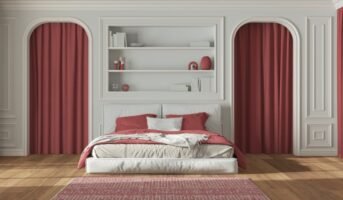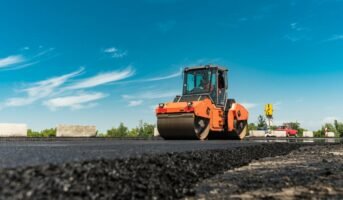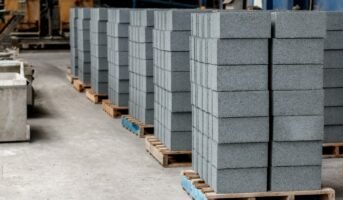A concrete wall is a wall constructed of concrete blocks of uniform size. The normal size is eight inches, although the block sizes may vary according to the guidelines and criteria established by an engineer for the concrete construction. A structure built of concrete blocks is susceptible to concrete corrosion, just like any other concrete structure, which is why anti-corrosive coverings are provided for concrete blocks.
For most of recent history, there have been concrete walls. Early concrete barriers were frequently constructed as a means of border security and were intended to fend off potential raids from nations or migrants in nearby areas. The Great Wall of China is among the best well-known concrete barriers in human history. It was constructed in the Qin Dynasty more than 2000 years ago to defend against raids from conquerors. It is the world’s biggest man-made construction.
How are concrete walls built?
An essential step in building construction is creating concrete walls. In addition to dividing spaces in multi-story buildings, it is built as a load-bearing framework to carry weights from the floor to the wall beneath or to the base. Additionally, concrete walls are a preferred structural component in earthquake-prone areas because of their good function during earthquakes. As a result, it has significant control over the building’s safety. Due diligence must be exercised throughout its building because of this. Finally, in addition to following proper building procedures, the materials utilized to build concrete walls significantly impact how well the wall performs throughout its lifespan.
Wooden shuttering of formwork in different shapes is used to construct walls of poured concrete. Concrete is deposited into various temporary or permanent forms that make up formwork. Although typically made of wood, it can also be made of steel, glass fibre, and reinforced polymers.
For a distinctive appearance, integral colour can also be put into the concrete mix and even poured into different layers. Vertical overlays are an excellent option for existing concrete wall fixes if you need to fix cracks or want to change how your wall looks. The steps are preparing the wall, putting on the overlay, and performing any desired ornamental treatments.
What aspect of the concrete wall finish is most important?
After the panel has been scraped, “tiny holes” or stains in various colours may appear on the concrete surface. There could be several causes for this. Using a subpar or insufficient release agent frequently results in stains and sometimes causes interactions with the concrete. Tiny holes or splits in concrete are typically caused by improper vibration or bad concrete selection. Both of these issues may also result from insufficient formwork cleaning.
Phenolic finish boards are generally recommended for structural or eye-catching finishes because of their glossy finish and extremely low leakage.
Which tests are most frequently used on newly laid concrete walls?
The most frequent tests are compressive strength, gas content, slumping, and basic weight checks. Slump is a metric for concrete’s consistency or relative flow ability. There may be issues with appropriate consolidation if the texture or slump of the concrete prevents it from flowing. If the slump is too great and the concrete won’t stop pouring, partition, increased formwork force, cement loss via the formwork, and finishing delays could all occur.
Because some air is lost during shipping, consolidation, placement, and polishing, air content only measures the overall volume in a fresh concrete test, not the actual in-place air content. There are three common field tests: the pressure meter, the volumetric technique, and the Chace Indicator, which is an AASHTO protocol.
The mass of a given new concrete volume is measured as unit weight.
Concrete cylinders are poured into testing the compressive power, and when the concrete hardens at certain intervals, the force required to crush the concrete cylinders is measured. Building Code Requirements for Tempered Concrete states that concrete is permitted if no one test results in a value more than 500 psi below the original force and the total of three successive tests equals or exceeds the design strength. If the strength tests don’t meet these requirements, measures must be taken to increase the average.
What causes concrete walls to spall and crumb?
Owing to one or more of the below mentioned reasons, walls may crack or spall:
Concrete must be air-entrained in regions of the country that experience cold and thawing to prevent peeling and cracking of the wall. If air-entrained concrete is not applied, the surface will eventually be harmed.
To increase the surface’s longevity, the water-to-cement ratio should be as minimal as possible. A concrete mix containing too much moisture will result in weaker, less resilient concrete that hastens the surface’s splitting and cracking.
It is best to wait until the extra flow of water on the top has had time to dissipate before starting the finishing process. If the finishing activities start too early and the extra water is mixed into the concrete, the concrete will be lighter and less stable because of the excessive water content.
How are stains on concrete walls removed?
Concrete stains can be cleaned mechanically or dry, or chemically or wet, utilsing wet procedures.
Sandblasting, fire cleaning, shot blasting, polishing, scabbing, levelling, and scouring are examples of common dry procedures. Steel-wire wipers should be handled carefully since they may deposit metal on the surface, causing the concrete walls to corrode and become stained.
According to the type of stain, wet procedures apply water or particular chemicals. The chemical process either whitens the staining material so it disappears or dissolves it so it may be wiped up from the concrete’s layer.
For instance, to get rid of blood stains wet the area with water, then sprinkle it with sodium peroxide dust. Keep it as it is for some seconds, and then wash it with water and wipe vigorously. Apply a vinegar solution at a concentration of 5% afterward to remove any leftover sodium peroxide.
What are some better concrete wall technologies?
Monolithic structure erection technology is more common in today’s construction, making it simple to design a free layout. Large private homes where you may apply any design ideas are perfect for it.
The weight on the base is properly spread when a building is constructed using a monolithic technique, and the entire structure functions as one cohesive unit.
Reinforced concrete walls, fired at relatively high degrees at the plant, share the same feature. As a result, most builders are attempting to finish the concrete job before the winter.
If not, extra attempts should be taken to warm it. Furthermore, it should be understood that building monolithic structures requires a lengthy process, which drives up the price of such dwellings. Apartments in this type of house will be at least 50 square meters in size.
If you want to live in one of these homes, consider the value of concrete features like sound insulation. The neighbours’ lives will be heard through the walls and attics if extra soundproofing measures are not implemented.
Concrete wall construction: Materials used
Tricalcium silicate is the substance that gives concrete its strength. Concrete hardens and gains strength with time. Concrete’s hardness is also influenced by the ingredients utilised. Water, fine and coarse particles, a binding agent, and an additive make up concrete (optional). The project’s needs determine concrete mixtures. The average ingredient percentages for concrete mixtures are 20% air and water, 40% pebbles, 10% cement, and 30% sand.
- Binding components, such as cement or lime, are crucial components in creating concrete. Cement or limestone is combined with water to create a slurry that ultimately bonds and solidifies into formations that resemble stones.
- As an adhesive, cement holds all the components together.
- Sand is a fine material in most cases, whereas broken stone and brick chips serve as coarse materials.
- Water is an important component of the combination, and the ideal ratio between water and cement is 0.4 to 0.6.
- The likelihood of the concrete melting and developing cracks increases with the amount of water used.
Concrete is used in many commonplace constructions. As long as construction projects are going on, there will be a big need for concrete because it is recyclable and ecologically beneficial.
Concrete wall construction: Equipment used
For the construction of a concrete wall, following equipment are required:
- Concrete mixing and delivery machinery
- Safety accessories for workers
- Concrete compaction and finishing equipment
Concrete walls: Durability and sustainability
When it comes to construction, durability is the first and foremost consideration. A structure should be enduring and safe. For this reason, concrete is the most popular material used for construction. It is well known for its durability, strength, safety and resilience in the face of disasters like earthquakes. As a bonus, concrete is also one of the most sustainable choices for construction due to its innate qualities like strength, thermal mass, durability, carbon uptake, local availability, recyclability, and resilience to extreme weather and hazards like fire.
Concrete wall cladding: A modern architectural trend
Concrete wall cladding has gained enormous popularity in both interior and exterior design of houses and other buildings. Concrete cladding panels are crafted with robust concrete and applied to either outside or inside of a building to improve its durability or enhance the aesthetic value of the space. There are many reasons for this trend’s increased momentum. Concrete wall cladding not only offers great protection against erosion and harsh weather but also offers resistance to fire, termites, and rust. In addition to boosting durability, it requires very little maintenance, is quite cost-effective, and offers high-performance insulation.
Concrete walls: A low-maintenance option for outdoor spaces
Concrete walls have become quite popular for outdoor spaces and landscaping projects. Whether you are looking to renovate your patio or build an outdoor deck, concrete is one of the best materials for construction. This is not only because of the durability and sustainability benefits it offers but also because it requires minimal upkeep. Once the construction gets done, you can enjoy your space for years without having to worry about maintenance.
Bottom line
We sincerely hope this knowledge will help you see the stunning world of new interior concrete walls. Concrete used within a room can be used to build a beauty based on your preferences and what draws you there. Interiors made of concrete are undoubtedly a craze that is growing. Also, if you are looking for a house to make your dream home, you can visit the website of housing.com. It is the best real estate marketing platform for home buyers, landlords, builders, and property brokers. The site provides listings for fresh and used houses, rentals, lands, and co-living areas.
FAQs
What are the top 5 brands of concrete?
The top brands of concrete are Ambuja, UltraTech, ACC, Ramco and Shree.
What is the typical cure time of concrete?
The recommended drying time for mortar and concrete is seven days.
How durable is precast concrete?
Precast concrete buildings must withstand a wide range of climatic factors, thus they have high expectations. Such items ought to have an ideal lifespan of 50 to 100 years or over.
Do concrete walls cost less money?
Positively, concrete is typically less expensive than other building materials. Additionally, they are typically easy to install, which results in decreased labour expenses.
How thin may walls made of concrete be?
A thin, external of concrete with an usual width of 1.5 to 3 inches makes up thin-shell wall boards.
Housing News Desk is the news desk of leading online real estate portal, Housing.com. Housing News Desk focuses on a variety of topics such as real estate laws, taxes, current news, property trends, home loans, rentals, décor, green homes, home improvement, etc. The main objective of the news desk, is to cover the real estate sector from the perspective of providing information that is useful to the end-user.
Facebook: https://www.facebook.com/housing.com/
Twitter: https://twitter.com/Housing
Email: [email protected]












